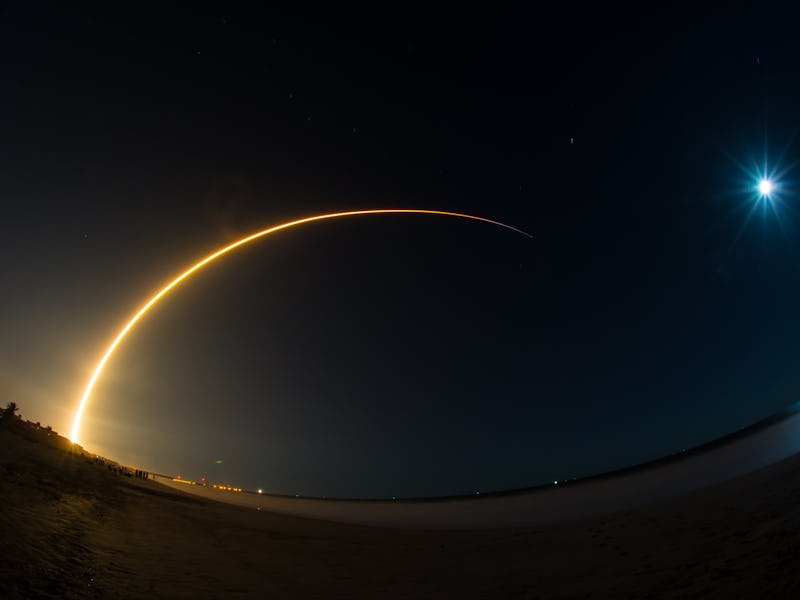Why SpaceX crashing into the Moon could actually be good for science
SpaceX launched a Falcon 9 rocket back in 2015, and its second stage is on course to hit the Moon.

SpaceX is about to make history — by accident.
An emerging picture reveals that the spaceflight company’s second stage is on a collision course with the Moon. Bill Gray, the creator of the Guide astronomical software that cataloged the data, claimed on his blog that it’s “the first unintended lunar impact we've had, period.”
The impact is expected to occur at 7:25 a.m. Eastern time on March 4. It’s expected to hit the Moon at latitude 4.93 and east longitude 233.20. Gray noted that his prediction might be wrong by “a degree or two minutes” from the projection.
But while it sounds like a major incident for SpaceX, Ars Technica notes that the impact could actually reveal some valuable scientific data. NASA previously launched the upper stage of a rocket toward a collision with the Moon to understand its composition.
Want to find out more about SpaceX’s plans for the future? Subscribe to MUSK READS+ for exclusive interviews and analysis about spaceflight, electric cars, and more.
SpaceX hits the Moon: What is going to hit the Moon?
In February 2015, SpaceX launched the Deep Space Climate Observatory for NASA, or DSCOVR. This satellite is located around one million miles from Earth, at the neutral point of gravity between the Earth and the Sun. The spacecraft can detect solar winds leaving the Sun around one hour before they hit Earth, which means it can act as an advanced warning system for Earth.
Because the spacecraft was sent so far out, the second stage propelling the satellite didn’t have the energy to return to Earth’s atmosphere and burn up. That means, unlike most of SpaceX’s missions, the second stage was left tumbling around the gravity of the Earth and Moon.
The second stage measures around four metric tons, Ars Technica notes. It’s also expected to hit the Moon at a speed of around 2.58 kilometers per second, or around 5,770 miles per hour.
SpaceX hits the Moon: Has anything else hit the Moon?
Yes. Look up at the Moon in the sky, and you’ll see it’s covered in craters. NASA’s Lunar and Planetary Institute explains that these craters were formed by asteroids and comets hitting the surface.
When one of these hits the Moon, it carves a crater much bigger than the object that hit the Moon. Material is ejected out in various directions.
NASA has purposefully used one of its missions to hit the Moon and observe the revealed material. The Lunar Crater Observation and Sensing Satellite, launched in 2009, struck the Moon in two locations. One was the satellite itself and the other was a rocket stage.
Both hit the Moon’s Cabeus crater on October 9 of that year. Both LCROSS and a companion satellite launched simultaneously, the Lunar Reconnaissance Orbiter, were able to analyze the material moved by the impact.
The LCROSS spacecraft.
The data showed a wealth of materials within the crater. Perhaps most strikingly, it confirmed the presence of water in the Cabeus crater. That discovery was perhaps most critical to the likes of SpaceX, who have expressed interest in building a permanent settlement on the Moon.
SpaceX hits the Moon: What does this incident mean for the Moon?
Unfortunately, SpaceX’s impact is unlikely to have the same scientific value.
Gray notes that the two orbiters observing the Moon, NASA’s LRO and India’s Chandrayaan-2, are unlikely to be in the right place to observe the impact when it happens. But when they do pass over, they may be able to observe the fresh crater.
The speed sounds high — 5,770 miles per hour — but it’s unlikely to have a dramatic effect on the Moon. LCROSS’s upper stage hit the Moon at 5,600 miles per hour, which means the speed is similar to that seen in an intentional impact.
In short, the Moon will be fine — and in the best-case scenario, it could reveal a little more about the Moon’s physical properties.
SUBSCRIBE TO MUSK READS+, A PREMIUM NEWSLETTER THAT COVERS THE WORLDS OF ELON MUSK, SPACEX, TESLA, AND EVERYTHING BETWEEN.
This article was originally published on